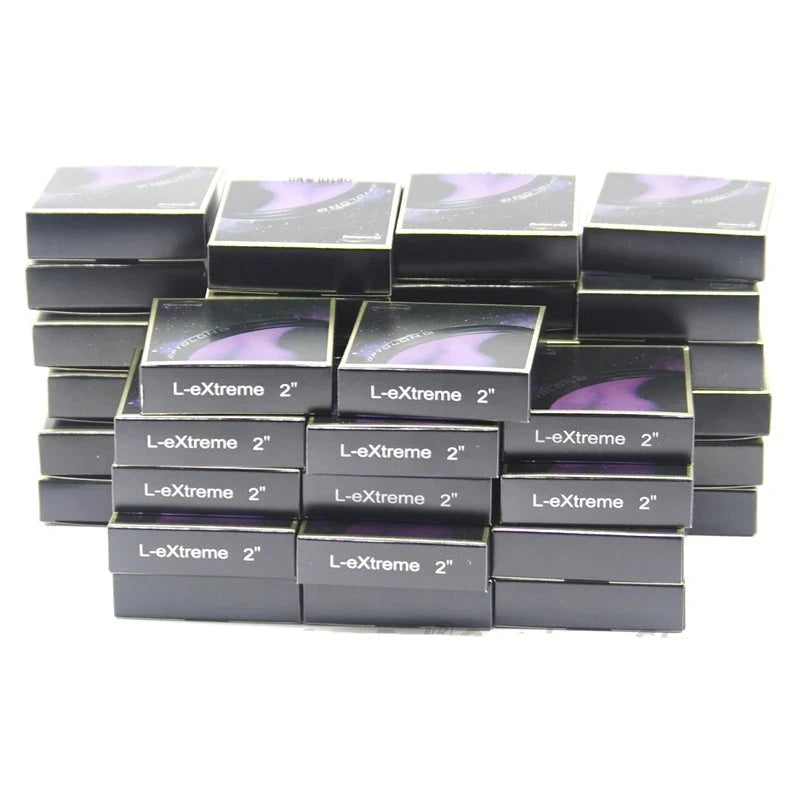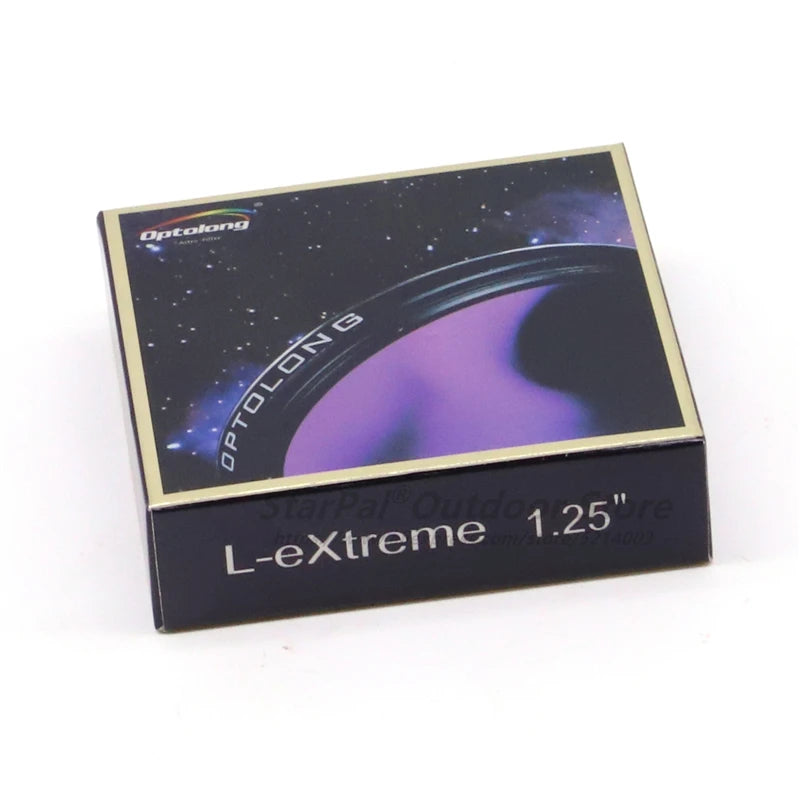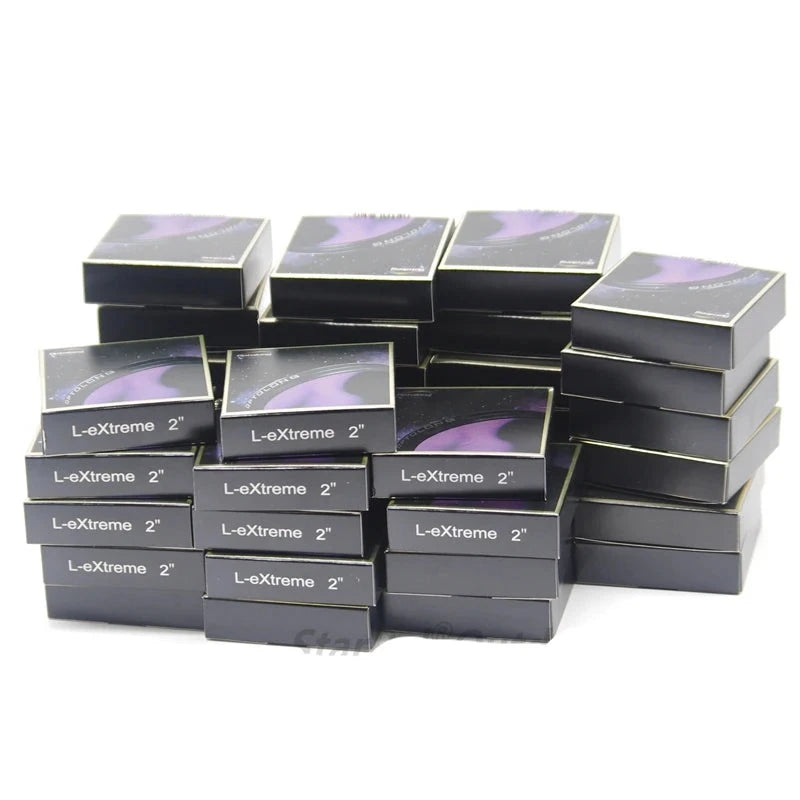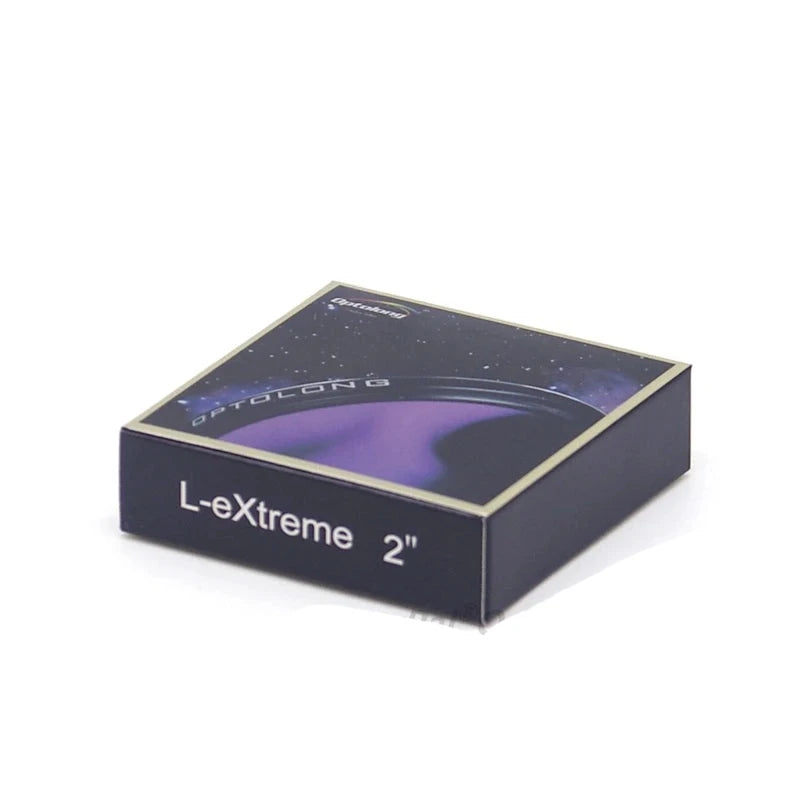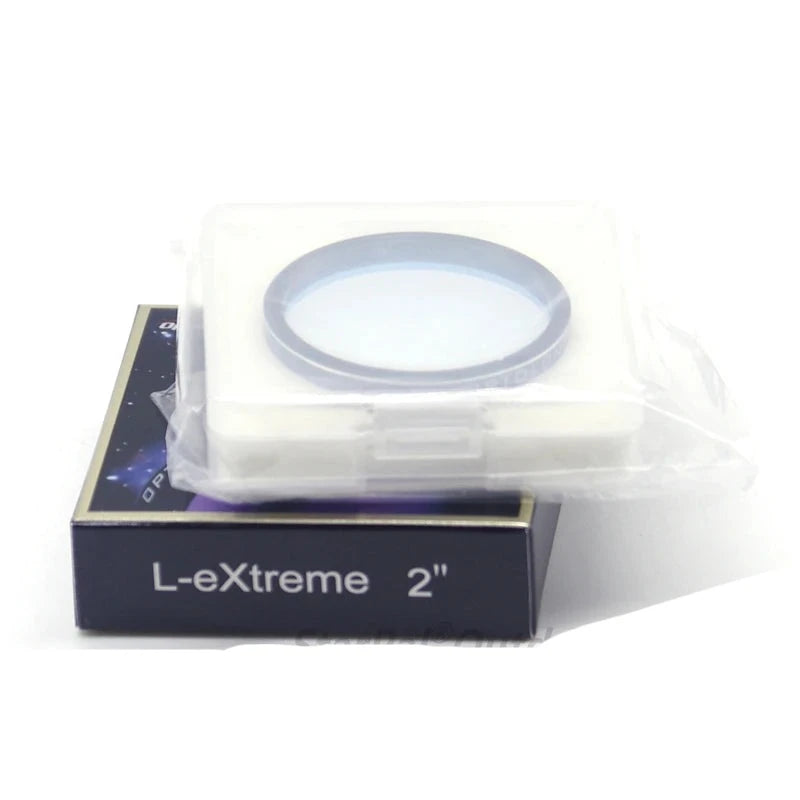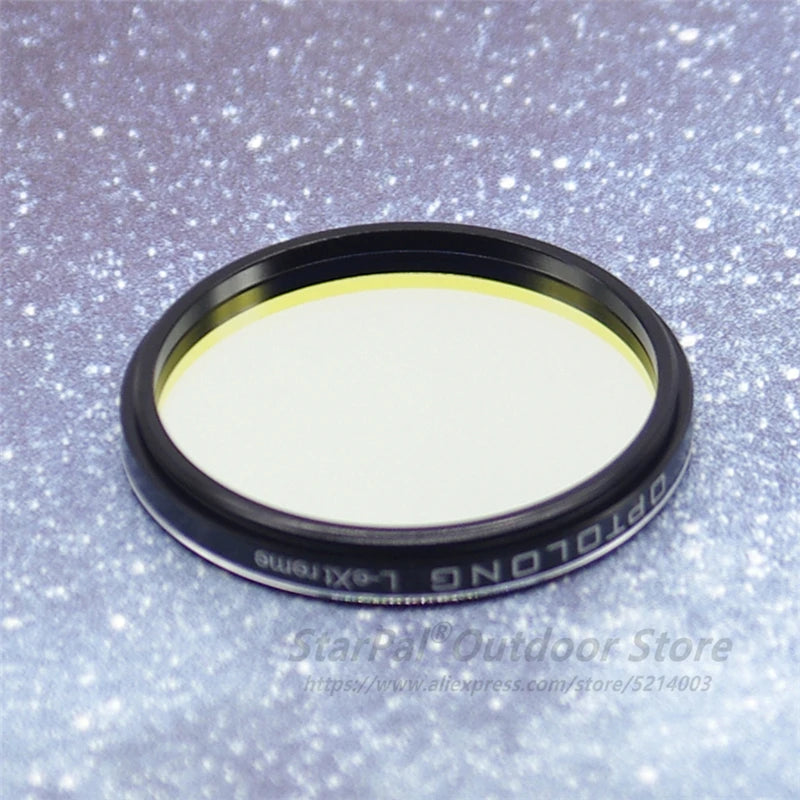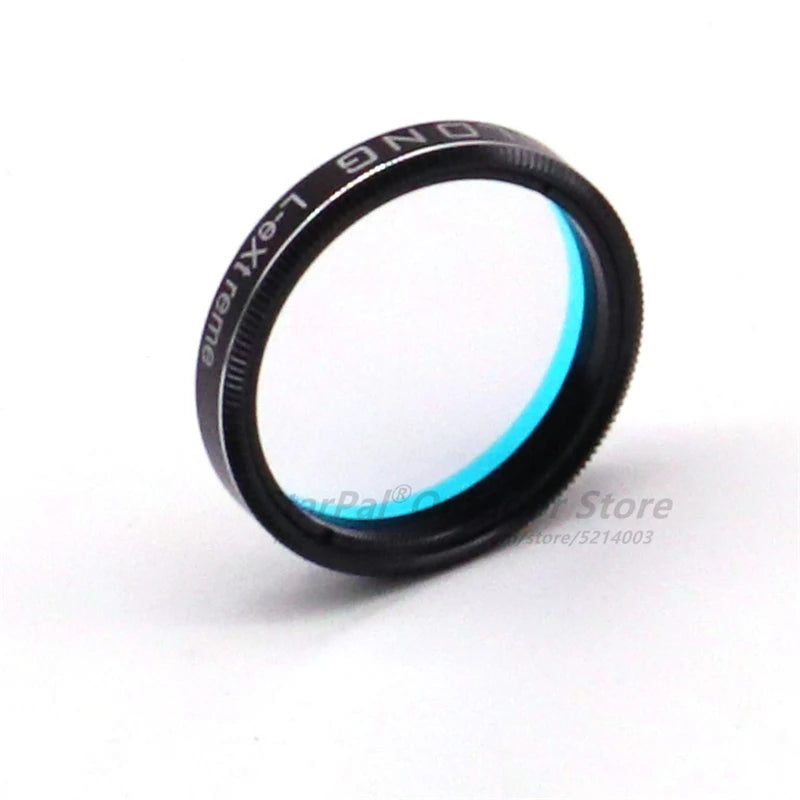Optolong
Optolong L-Extreme 7nm Dual-Band Narrowband Light Pollution Filter
Optolong L-Extreme 7nm Dual-Band Narrowband Light Pollution Filter
FREE SHIPPING
Couldn't load pickup availability
Optolong L-eXtreme 7nm Dual Narrowband Light Pollution Filter
Introducing the Optolong L-eXtreme 7nm Dual-Band Narrowband Light Pollution Filter
The Optolong L-eXtreme 7nm Dual-Band Narrowband Light Pollution Filter is a game-changer for astrophotographers and astronomers who aim to capture breathtaking images of the cosmos. Designed to isolate and transmit the H-alpha (656.28nm) and OIII (500.7nm) emission lines, this filter dramatically enhances the contrast and detail of nebulae, even in heavily light-polluted skies. Available in both 1.25" and 2" sizes, the Optolong L-eXtreme filter is perfect for use with DSLR cameras, CCD cameras, and fast optical systems, providing exceptional performance at an affordable price.
Features of the Optolong L-eXtreme 7nm Dual Narrowband Light Pollution Filter
The Optolong L-eXtreme 7nm Dual-Band Narrowband Light Pollution Filter boasts an array of advanced features that make it indispensable for deep-sky imaging:
- Dual-Band Pass Filter: Captures specific wavelengths at 500.7nm (OIII) and 656.28nm (H-alpha) with a Full Width at Half Maximum (FWHM) of 7nm.
- Optimized for Fast Optical Systems: Designed for use with fast focal ratio imaging systems, including RASA, HyperStar, and other systems with focal ratios from f2 to f3.3.
- High Transmission Rates: Ensures high transmittance for OIII and H-alpha bands, enhancing image clarity and detail.
- Effective Light Pollution Blocking: Blocks unwanted light pollution, significantly improving contrast and detail in celestial images.
- Advanced Coating Technology: Multi-layer anti-reflection coating, non-cementing optical substrate coating, and ion-assisted deposition coating technology for enhanced durability and scratch resistance.
- Precision Engineering: Utilizes a planetary rotation system for precision and homogeneity of coatings, ensuring high transmission values and optical density of off-band.
- Durable Construction: Made from high-quality B270 optical glass with a substrate thickness of 1.85mm.
- Superior Surface Quality: Fine-optically polished to 1/4 wave and <30 parallelism over both surfaces, with a surface quality of 60/40 according to MIL-O-13830 standards.
Applications of the Optolong L-eXtreme 7nm Dual-Band Narrowband Light Pollution Filter
This filter is ideal for a variety of astronomical applications, particularly for deep-sky imaging in light-polluted areas:
- Deep-Sky Imaging: Perfect for capturing detailed images of nebulae and other celestial objects in the OIII and H-alpha emission lines.
- Light Pollution Reduction: Effective in reducing the impact of light pollution, making it suitable for imaging in both urban and suburban environments.
- Astrophotography: Suitable for use with one-shot color cameras, monochrome cameras, and DSLRs for high-quality astrophotography.
- Fast Optical Systems: Optimized for use with fast focal ratio telescopes such as RASA, HyperStar, and others in the f2 to f3.3 range.
Benefits of Using the Optolong L-eXtreme 7nm Dual Narrowband Light Pollution Filter
Incorporating the Optolong L-eXtreme 7nm Dual-Band Narrowband Light Pollution Filter into your astronomical setup offers numerous benefits:
- Enhanced Image Quality: Achieve high-contrast, detailed images of nebulae and other celestial objects by isolating specific wavelengths of light.
- Reduced Light Pollution: Effectively blocks unwanted wavelengths, significantly reducing the impact of light pollution and improving image clarity.
- Versatile Compatibility: Compatible with a range of imaging setups, including one-shot color cameras, monochrome cameras, and DSLRs.
- Durable and Reliable: Constructed from high-quality materials and advanced manufacturing processes, ensuring long-lasting performance.
- Optimized for Fast Systems: Specifically designed for fast optical systems, providing optimal performance in a variety of imaging scenarios.
What is the Optolong L-eXtreme 7nm Dual-Band Narrowband Light Pollution Filter Used For?
The Optolong L-eXtreme 7nm Dual-Band Narrowband Light Pollution Filter is designed to enhance the visibility and detail of celestial objects by capturing specific wavelengths of light. This makes it ideal for:
- Deep-Sky Imaging: Capturing detailed images of nebulae and other celestial objects in the OIII and H-alpha emission lines.
- Light Pollution Reduction: Reducing the impact of light pollution to achieve clearer and more detailed images.
- Astrophotography: Providing high-quality images with one-shot color cameras, monochrome cameras, and DSLRs.
- Fast Optical Systems: Optimizing performance in fast focal ratio telescopes, such as RASA, HyperStar, and others.
Usage Instructions for the Optolong L-eXtreme 7nm Dual Narrowband Light Pollution Filter
Using the Optolong L-eXtreme 7nm Dual-Band Narrowband Light Pollution Filter is straightforward and efficient. Here’s how to get started:
- Attach the Filter: Secure the filter to the 1.25-inch or 2-inch eyepiece or camera adapter of your telescope using the standard thread.
- Adjust Focus: Adjust your telescope’s focus to get a clear view of your target object.
- Capture Images: Begin your astrophotography session, taking advantage of the enhanced clarity and reduced light pollution provided by the filter.
- Store Safely: After use, store the filter in its protective case to prevent damage and contamination.
Tips for Getting the Best Results with the Optolong L-eXtreme 7nm Dual-Band Narrowband Light Pollution Filter
To maximize the performance of your Optolong L-eXtreme 7nm Dual-Band Narrowband Light Pollution Filter:
- Use in Clear Skies: For optimal results, use the filter under clear and dark skies.
- Combine with Other Filters: Consider using other narrowband filters to capture different wavelengths of light from celestial objects.
- Regular Maintenance: Clean your filters and telescope lenses regularly to ensure the highest image quality.
- Experiment with Different Objects: Try imaging various celestial objects to fully appreciate the benefits of the dual-band narrowband filter.
FAQ: Common Questions About the Optolong L-eXtreme 7nm Dual Narrowband Light Pollution Filter
Q: Can I use the Optolong L-eXtreme Filter with any telescope? A: The filter is optimized for use with fast focal ratio telescopes, such as RASA, HyperStar, and others in the f2 to f3.3 range. It can be used with any telescope that accommodates 1.25-inch or 2-inch eyepieces or camera adapters.
Q: Does the filter effectively reduce light pollution? A: Yes, the filter is designed to block unwanted wavelengths of light, significantly reducing the impact of light pollution and enhancing image clarity.
Q: Is the filter suitable for both visual observation and astrophotography? A: The filter is primarily designed for astrophotography, providing high performance with one-shot color cameras, monochrome cameras, and DSLRs.
Q: Can I use this filter for sun observation? A: The filter is not intended for direct solar observation. Always use appropriate solar filters and safety precautions when observing the Sun.
Q: How should I clean and store the filter? A: Clean the filter gently with a soft, lint-free cloth and store it in its protective plastic case when not in use to prevent damage.
Why Should You Buy the Optolong L-eXtreme 7nm Dual-Band Light Pollution Filter?
The Optolong L-eXtreme 7nm Dual-Band Narrowband Light Pollution Filter is an essential tool for anyone serious about astrophotography. Its ability to capture specific wavelengths of light and reduce the impact of light pollution makes it invaluable for capturing detailed images of nebulae and other celestial objects. With its high-quality construction and advanced features, this filter will significantly improve your stargazing and imaging experience.
Popular Targets for the Optolong L-eXtreme Filter
The Optolong L-eXtreme 7nm Dual-Band Narrowband Light Pollution Filter is a powerful tool for capturing stunning images of deep-sky objects, particularly emission nebulae. By isolating the H-alpha (656.28nm) and OIII (500.7nm) emission lines, this filter allows astrophotographers to achieve high-contrast, detailed images, even in light-polluted areas. Below are some of the most popular and visually striking targets for the Optolong L-eXtreme filter.
Nebulae
1. The Orion Nebula (M42)
The Orion Nebula is one of the most famous and bright nebulae in the night sky, located in the constellation Orion. It is an excellent target for the Optolong L-eXtreme filter due to its strong emission in both the H-alpha and OIII lines. The filter helps to enhance the contrast and detail of the nebula's intricate structures and vibrant colors.
- Coordinates: RA 05h 35m 17s | Dec -05° 23′ 28″
- Magnitude: 4.0
- Best Viewing Time: Winter (Northern Hemisphere)
2. The Horsehead Nebula (Barnard 33)
The Horsehead Nebula is a dark nebula located in the constellation Orion, near the bright star Alnitak. The filter's ability to isolate H-alpha emissions makes the dark silhouette of the Horsehead Nebula stand out against the bright background of ionized hydrogen gas.
- Coordinates: RA 05h 40m 59.0s | Dec -02° 27′ 30″
- Magnitude: 6.8
- Best Viewing Time: Winter (Northern Hemisphere)
3. The Rosette Nebula (NGC 2237)
The Rosette Nebula, located in the constellation Monoceros, is a large circular emission nebula. The Optolong L-eXtreme filter helps bring out the rich H-alpha and OIII emissions, highlighting the nebula's intricate petal-like structure.
- Coordinates: RA 06h 31m 55.5s | Dec +04° 56′ 34″
- Magnitude: 9.0
- Best Viewing Time: Winter (Northern Hemisphere)
4. The North America Nebula (NGC 7000)
The North America Nebula in the constellation Cygnus resembles the shape of the continent. The filter's dual-band pass capabilities enhance the nebula's H-alpha and OIII regions, making the "Gulf of Mexico" and other features more prominent.
- Coordinates: RA 20h 58m 42s | Dec +44° 20′ 00″
- Magnitude: 4.0
- Best Viewing Time: Summer to Fall (Northern Hemisphere)
5. The Pelican Nebula (IC 5070)
Located near the North America Nebula, the Pelican Nebula is another great target. The filter enhances the contrast of the H-alpha and OIII emissions, making the pelican-like shape of the nebula more defined.
- Coordinates: RA 20h 51m 00s | Dec +44° 00′ 00″
- Magnitude: 8.0
- Best Viewing Time: Summer to Fall (Northern Hemisphere)
Supernova Remnants
6. The Veil Nebula (NGC 6960, NGC 6992)
The Veil Nebula in the constellation Cygnus is a large supernova remnant with complex filamentary structures. The Optolong L-eXtreme filter enhances the visibility of the delicate strands of ionized gas, particularly in the H-alpha and OIII wavelengths.
- Coordinates: RA 20h 45m 38s | Dec +30° 42′ 30″
- Magnitude: 5.0
- Best Viewing Time: Summer (Northern Hemisphere)
7. The Crab Nebula (M1)
The Crab Nebula, located in the constellation Taurus, is the remnant of a supernova explosion. The filter helps to reveal the intricate details of the nebula's filaments, which emit strongly in both H-alpha and OIII.
- Coordinates: RA 05h 34m 31.94s | Dec +22° 00′ 52.2″
- Magnitude: 8.4
- Best Viewing Time: Winter (Northern Hemisphere)
Planetary Nebulae
8. The Dumbbell Nebula (M27)
The Dumbbell Nebula in the constellation Vulpecula is one of the brightest planetary nebulae in the sky. The Optolong L-eXtreme filter enhances the nebula's H-alpha and OIII emissions, bringing out the details of its distinctive hourglass shape.
- Coordinates: RA 19h 59m 36.34s | Dec +22° 43′ 16.1″
- Magnitude: 7.4
- Best Viewing Time: Summer (Northern Hemisphere)
9. The Ring Nebula (M57)
The Ring Nebula, located in the constellation Lyra, is a small but bright planetary nebula. The filter helps to emphasize the nebula's ring structure by enhancing the H-alpha and OIII emissions.
- Coordinates: RA 18h 53m 35.079s | Dec +33° 01′ 45.03″
- Magnitude: 8.8
- Best Viewing Time: Summer (Northern Hemisphere)
Diffuse Nebulae
10. The Lagoon Nebula (M8)
The Lagoon Nebula in the constellation Sagittarius is a large and bright diffuse nebula. The Optolong L-eXtreme filter enhances the rich H-alpha and OIII regions, bringing out the nebula's intricate details and structure.
- Coordinates: RA 18h 03m 37s | Dec -24° 23′ 12″
- Magnitude: 6.0
- Best Viewing Time: Summer (Northern Hemisphere)
11. The Eagle Nebula (M16)
The Eagle Nebula, located in the constellation Serpens, is famous for the "Pillars of Creation" within it. The filter's ability to isolate H-alpha and OIII emissions enhances the visibility of these iconic structures and the surrounding nebula.
- Coordinates: RA 18h 18m 48s | Dec -13° 49′ 00″
- Magnitude: 6.0
- Best Viewing Time: Summer (Northern Hemisphere)
Reflection Nebulae
12. The Trifid Nebula (M20)
The Trifid Nebula in the constellation Sagittarius is a combination of an emission nebula and a reflection nebula. The Optolong L-eXtreme filter helps to bring out the contrast in the emission regions, highlighting the nebula's unique structure.
- Coordinates: RA 18h 02m 23s | Dec -23° 01′ 48″
- Magnitude: 6.3
- Best Viewing Time: Summer (Northern Hemisphere)
Other Popular Targets
13. The Heart Nebula (IC 1805)
Located in the constellation Cassiopeia, the Heart Nebula is rich in H-alpha emissions, making it an excellent target for the Optolong L-eXtreme filter. The filter helps to enhance the intricate structures and details within the nebula.
- Coordinates: RA 02h 32m 42s | Dec +61° 27′ 00″
- Magnitude: 6.5
- Best Viewing Time: Fall to Winter (Northern Hemisphere)
14. The Soul Nebula (IC 1848)
Adjacent to the Heart Nebula, the Soul Nebula is another spectacular target for the L-eXtreme filter. The filter's ability to isolate H-alpha and OIII emissions enhances the visibility of the nebula's complex structures.
- Coordinates: RA 02h 51m 00s | Dec +60° 26′ 00″
- Magnitude: 6.5
- Best Viewing Time: Fall to Winter (Northern Hemisphere)
Specifications of the Optolong L-eXtreme 7nm Dual-Band Narrowband Light Pollution Filter (1.25" / 2")
- Filter Size: 1.25 inches or 2 inches
- Bandwidth: 7nm at 500.7nm (OIII) and 656.28nm (H-alpha)
- Transmission: 95% at bandpass
- Optical Quality: Multi-layer anti-reflection coating, non-cementing optical substrate coating
- Material: B270 substrate material, aluminum frame
- Surface Quality: 60/40 according to MIL-O-13830
- Surface Parallelism: 1/4λ, <30 parallelism over both surfaces
- Thread: Standard M28.5x0.6mm for 1.25" and M48x0.75mm for 2"
- Shape: Round
- Net Weight: 3g / 0.12oz
Package Content
When you purchase the Optolong L-eXtreme 7nm Dual-Band Narrowband Light Pollution Filter, you will receive:
- 1 x Optolong L-eXtreme 7nm Dual-Band Narrowband Light Pollution Filter: The main component, designed to improve your astronomical observations.
- 1 x Protective Plastic Storage Case: Made from durable PP material to protect your filter when not in use.
Order Now
Transform your astronomical observations and astrophotography with the Optolong L-eXtreme 7nm Dual-Band Narrowband Light Pollution Filter. Order now to enjoy clear, high-contrast images of nebulae and other celestial objects and capture the beauty of these wonders with unprecedented detail. Click the link below to add this essential tool to your collection today.
The Optolong L-eXtreme 7nm Dual-Band Narrowband Light Pollution Filter is a powerful tool for any astronomer or astrophotographer looking to capture high-contrast, detailed images of the night sky. With its advanced coating technology, high transmission rates, and durable construction, this filter ensures that you can achieve stunning results in a variety of imaging scenarios. Whether you’re observing from a suburban backyard or a light-polluted urban environment, the Optolong L-eXtreme filter will help you see the universe in greater detail than ever before. Don't miss out on the opportunity to improve your stargazing and astrophotography experience. Order your Optolong L-eXtreme 7nm Dual-Band Narrowband Light Pollution Filter today and start capturing the cosmos with unmatched clarity and precision.
Share


